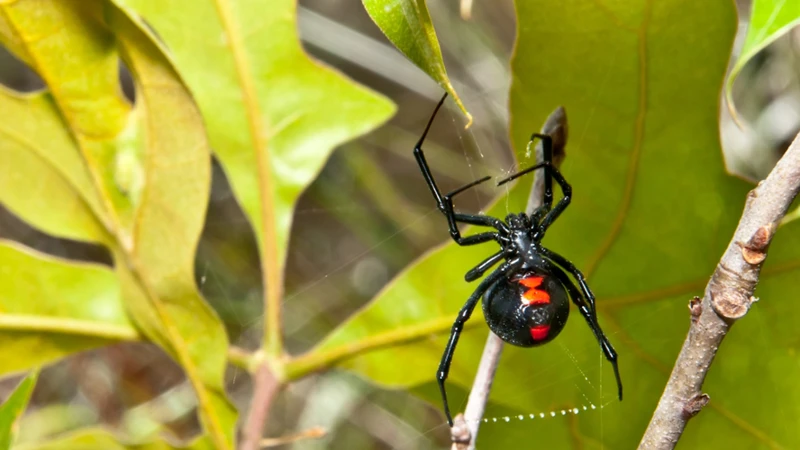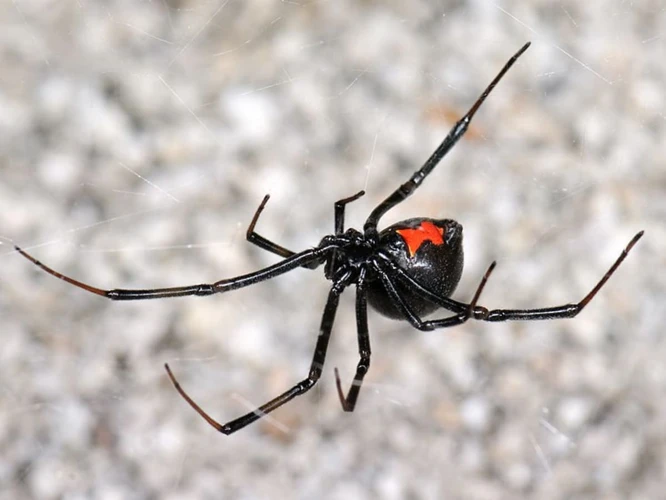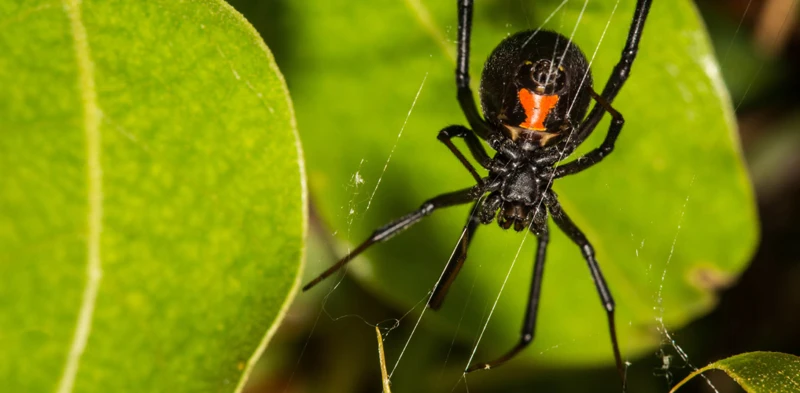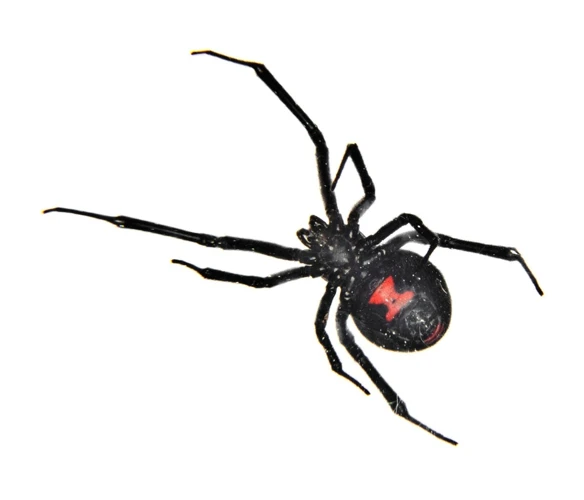Have you ever wondered about the hidden lives of black widow spiders? These eight-legged arthropods have gained a notorious reputation, but they also play a significant role in the ecosystem. Understanding their ecological niche could shed light on their importance to the environment and how they interact with other species. In this article, we will explore the habitat and feeding habits of black widow spiders, uncover their ecological role, and emphasize the importance of understanding their niche in the ecosystem. So buckle up and get ready to unravel the mysteries of one of the deadliest spiders on the planet.
The Habitat of Black Widow Spiders

The environment that Black Widow Spiders prefer to inhabit is varied and complex. These spiders can thrive in a variety of different habitats, from hot deserts to highly populated urban areas. Understanding the ecological niche of Black Widow Spiders is crucial to understanding where they live and why they live there. This section will delve into the different aspects of the habitat of Black Widow Spiders, including their geographical distribution and the physical environment they prefer. So, let’s take a closer look at where these spiders prefer to call home. To learn more, check out black widow habitats.
Geographical Distribution
Black Widow Spiders are found mainly in the warmer regions of the world, including Africa, Asia, North America, and Australia. They have a wide geographical distribution that spans across different continents and countries. These spiders prefer to live in warm, dry habitats where they can find shelter, moisture, and food.
Their habitats can be found in a diverse range of environments such as deserts, forests, agricultural fields, and even suburban and urban areas. They can often be found in areas that have a lot of vegetation or areas that are close to water sources. Black Widow Spiders are also common in buildings, sheds, and garages.
Despite the fact that they can survive in different habitats, the ideal habitat for these spiders is one that has ample vegetation, humidity, and shelter. The ideal habitat suits their habits of reproduction and predation as well. Female Black Widows prefer to live in places where they can find food, build webs and lay eggs. They also prefer locations that provide hiding places to protect their young from predators.
The distribution of Black Widows may vary by geography and climate. In North America, the spiders are more commonly found in the southern regions of the United States. They are less common in areas with cold winters such as Canada and Alaska. In Australia, they are widespread across the country except in Tasmania. In Africa, their distributions are irregular, with a concentration in certain areas.
Understanding the distribution of Black Widow Spiders can help people living in certain regions take the necessary precautions and avoid potential threats. For instance, if you live in an area with high habitat suitability according to the Black Widow Habitat Suitability Index, you may be more at risk of encountering these spiders. However, it’s important to note that not all locations that may be suitable habitats will have Black Widows, but it pays to know the potential risks and take the necessary precautions.
The distribution of Black Widow Spiders is influenced by various factors, including geographical location, vegetation, and availability of hiding places. For more information on factors that attract Black Widow Spiders, visit our page on ‘attracting Black Widows.’
Physical Environment
Black Widow Spiders usually inhabit warm areas with mild winter temperatures. They tend to prefer living in habitats that offer shelter and safety from predators, such as rocks, logs, debris, and other locations that are hidden from the view. They are known to adapt to different types of environments, including deserts, grasslands, forests, and even human-made structures, such as sheds and garages.
Structural complexity is an important factor when it comes to the physical environment of black widow spiders. They prefer living in habitat areas with a high degree of complexity, which means there are a variety of habitats available to hide and make webs. Research has also shown that these spiders are usually found in areas with greater vegetation cover. Vegetative cover provides a suitable microclimate for the spiders to control their body temperature and maintain moisture.
Moisture is another key factor that influences the Black Widow Habitat. As Black Widow Spiders have poor water retention abilities, increasing ambient moisture levels provide better avenues for controlling water loss. Factors such as soil texture, vegetation density, and humidity dictate how favorable their habitat would be.
Interestingly, black widow spiders can be found in both urban and rural areas, but human-made structures and high degree of human activity can increase the likelihood of finding these spider populations in urban areas. This is because artificial habitats provide numerous hiding places and shelter, while human activity may sometimes control the spider’s natural predators to some extent.
Black widow spiders also show a preference for areas with a low light intensity. Research has suggested that these spiders tend to move away from brightly lit locations and prefer areas in darkness or low light intensity. This prime reason for this is to remain unnoticed by their prey.
Understanding the physical environment and the factors that influence it, such as habitat structure, moisture, and light intensity, can help us better understand the ecological niche of Black Widow Spiders. It also helps to consider the interactions with other creatures and the impact of the spider on ecosystems. To learn more about the impact of physical environmental factors on Black Widow Spiders, check out a resource like “Structural Complexity and Habitat Suitability Index for Black Widow Spiders”.
The Feeding Habits of Black Widow Spiders

Black widow spiders are known for their venomous bite, which can be fatal to humans in certain cases. But what are the feeding habits of these spiders that make them in need of such potent venom? In this section of the article, we will explore the diet of black widow spiders and how they hunt their prey to survive in their specific ecological niche. Understanding the feeding habits of these spiders can help us better comprehend their role in the ecosystem and how they interact with other species in their habitat. But before we dive into their feeding habits, let’s briefly discuss the habitat where black widow spiders thrive. If you want to learn more about their habitat, check out this article that describes how moisture influences the black widow habitat.
Their Diet
Black widow spiders are known for their unique and selective diet. These spiders are carnivores and mainly feed on insects such as flies, mosquitoes, caterpillars, and grasshoppers. They also consume other arachnids like scorpions and even their own species. The diet of these spiders plays a significant role in their growth and reproduction.
Black widow spiders have a powerful venomous bite, that helps them catch their prey. They use their fangs to inject paralyzing venom into their prey before wrapping them up in their silk webs. A black widow spider’s diet is an essential component of their behavior and overall survival.
Here is a brief list of the Black Widow Spider’s diet:
- Flies
- Mosquitoes
- Caterpillars
- Grasshoppers
- Scorpions
- Other arachnids
It’s important to note that their diet is also impacted by their habitat availability. The prey availability is one of the most crucial factors that determine the ecological niche of black widow spiders. Studies have shown that certain environments provide more prey options for black widow spiders, and hence they can thrive more in those habitats.
In some cases, black widow spiders have been found near human habitats. Their diet includes pests, such as flies and mosquitoes, which can be beneficial in controlling such insects. However, their proximity to human habitats can also be a potential threat to humans.
Understanding the feeding habits of black widow spiders, including their diet and hunting behavior, is essential for controlling potential threats. In the following sections, we will discuss the ecological role of black widow spiders, their interaction with other species, and the impact they have on the ecosystem.
The Hunting Behavior
Black widow spiders, like most spiders, are carnivorous. Their hunting behavior primarily involves the use of webs to capture prey. Black widows spin webs that are strong and sticky, designed to trap and subdue their prey. They usually build their webs in dark and secluded places where insects, their primary prey, are known to frequent, such as under rocks, in crevices, and in cluttered areas.
These spiders have a distinctive hunting behavior that involves waiting on their webs for unsuspecting prey to fall into the trap, or they may actively hunt for prey if they are hungry. Once prey are caught, black widow spiders typically bite them to inject venom that results in paralysis and overcomes the prey’s defenses. This venom contains powerful neurotoxins that target the nervous system of the prey, causing muscle spasms, respiratory failure, and death.
Black widows are known for their potent venom, which can be dangerous to humans if not treated promptly. These spiders are not aggressive and only bite when they feel threatened or provoked. Their hunting behavior and the venomous nature of their bite has contributed to their infamous reputation as one of the world’s most venomous spiders.
It is interesting to note that the hunting behavior of black widow spiders may differ depending on their habitat and environmental conditions. For example, black widows in urban areas may have different hunting behaviors compared to those in rural areas due to differences in their habitat and the availability of prey. Additionally, external factors such as light can also impact their hunting behavior and web-building habits.
Understanding the hunting behavior of black widow spiders is important as it helps us understand their ecological niche and also allows us to take necessary precautions to avoid interactions with these spiders.
The Ecological Role of Black Widow Spiders

As one of the most notorious spiders in the world, the black widow spider is often vilified and feared for its venomous bite. However, these spiders also play a vital ecological role in their native habitats. Understanding the ecological niche of black widow spiders is crucial not only for their conservation but also for maintaining the balance of the ecosystem they inhabit. Let’s delve into the fascinating ecological role of black widow spiders and their relationships with other species – including humans – in their environment. One of the factors that determine the black widow’s ecological behavior is their physical environment. Understanding their habitats’ distinct characteristics is essential for comprehending their ecological effects.
Predator-Prey Relationship
Black widow spiders have a significant role in the predator-prey relationship within their ecosystems. They prey on insects, which helps control their populations, and in turn, acts as a food source for their predators such as birds, reptiles, and amphibians.
It’s interesting to note that the black widow spider’s venom, which is used to paralyze their prey, is also effective at protecting them from being eaten by predators. This venom is toxic to many animals, including humans, and acts as a defense mechanism.
However, some predators such as spider wasps have developed an immunity to the venom and are known to prey on black widows. This unique predator-prey relationship has resulted in an evolutionary arms race between the two species.
In addition to their role in the food chain, black widows also serve as hosts for parasitic wasps that lay their eggs on or inside the spiders. The wasp larvae then consume the spider as they mature. This relationship may seem gruesome, but it’s an important aspect of the ecosystem’s overall balance.
Understanding the predator-prey relationship of black widows is crucial to understanding the role they play in their respective habitats. It can also help us better understand how changes in the environment, such as urbanization or climate change, may impact their populations and the ecosystems they inhabit.
Human interaction with black widow habitats and the impact of light on black widow spiders are two examples of how our actions can disrupt these relationships and potentially harm the overall ecological balance.
Their Interaction with other Species
Black widow spiders have a complex interaction with other species in their ecological niche. Being an apex predator, they have a significant impact on the ecosystem around them. Their food chain involves not only their prey but also other predators like birds, reptiles, and mammals. These predators tend to avoid black widow spiders due to their venomous bite, and this gives them an advantage in their feeding habits.
Another interesting aspect of the interaction between black widow spiders and other species is their shelter-seeking behavior. Many animals prefer living in abandoned burrows or crevices that have been previously occupied by black widow spiders. This behavior is known as commensalism, where the animal benefits from the shelter without harming or benefiting the spider. For example, several species of spider, including the cobweb spider, like to inhabit the web of black widow spiders and feed on their leftover food.
However, competition for resources can also occur between the black widow spider and other invertebrates. One example is the redback spider, which is closely related to the black widow spider. The two species share a similar ecological niche, and competition for resources can be high between them. They both hunt small insects, which can be a limiting factor, and this leads to competition between the two species.
The interaction between black widow spiders and other species is complex, and it can vary depending on the ecological niche in question. It is essential to understand this interaction to protect and conserve these species’ habitats and the ecosystem around them. To learn more about black widow spiders, check out our article on how to attract black widows or habitat threats.
Impact on the Ecosystem
The presence of black widow spiders can have a significant impact on the ecosystem, particularly on the populations of insects and other arthropods in the area. These spiders are known for their potent venom and their ability to capture and consume their prey in copious amounts. As a result, they play a key role in controlling the populations of insects in their habitat.
Despite being common in many parts of the world, black widow spiders are adapted to specific environments and their habitat suitability index has been studied to understand where they thrive and what factors contribute to their success. A study showed that the availability of shelters, such as debris piles and rocks, greatly influenced the distribution of black widow populations.
In addition to their role as predators, black widow spiders also interact with other species in their environment. They have been observed to be aggressive towards other spiders and insects, which can impact the diversity of arthropods in their ecosystem. On the other hand, some animals, such as birds and lizards, have evolved resistance to the venom of black widows which allows them to prey on these spiders.
Considering their vital role in insect control and their impact on the ecosystem, it is important to understand the urban and rural habitats where black widow spiders can be found. However, studies have shown that urbanization affects the spider’s behavior and can result in changes to their feeding habits, reproduction, and even their venom toxicity.
The impact of light on black widows has also been studied and it was found that the spiders were drawn to artificial light sources, which may be due to their attraction to insects gathering around these lights. This could also cause changes in the spider’s behavior and disrupt their natural patterns.
A better understanding of the impact of black widow spiders on the ecosystem is crucial for maintaining a balanced ecosystem. Knowing their habitat preferences, feeding habits, and interactions with other species can help to manage and conserve their populations and ensure their continued role in controlling insect populations.
Why Understanding the Ecological Niche is Important?
Understanding the ecological niche of black widow spiders is crucial for several reasons. Firstly, it helps in assessing the suitability of black widow spider’s habitat. By knowing the physical environment requirements, including temperature, humidity, and vegetation, one can predict if a particular location is good for sustaining black widow spiders. According to the Black Widow Habitat Suitability Index, understanding an ecosystem’s various physical and biological factors can provide an effective model for predicting where black widow spiders are likely to be found.
Secondly, studying the ecological niche of black widow spiders involves understanding their interactions with other species in their ecosystem. Black widow spiders interact with several species, both prey and predators. The interactions between black widow spiders and other species help in maintaining ecological balance in their habitat.
Understanding the ecological niche also sheds light on black widow spider’s shelter requirements. For example, they prefer living in undisturbed places, making piles of debris, overgrown vegetation, and abandoned structures, such as barns and sheds, their preferred habitats. Understanding this can help humans avoid unwanted contact with these venomous spiders and prevent accidental bites. Black widow spiders’ habitat preferences and shelter requirements can also guide urban planners in designing green spaces that are less attractive to black widow spiders.
Lastly, understanding the ecological niche of black widow spiders can help us comprehend their impact on the ecosystem. Apart from acting as a natural pest control agent, the venom of this spider is bioactive, and studies have suggested its potential medicinal uses. However, excessive black widow spider populations can lead to competition for food and predation of beneficial insects, disrupting the ecological balance of the ecosystem. Urbanization and land-use changes may alter the ecological niche of black widow spiders, leading to an increase or decrease in their populations.
Understanding the ecological niche of black widow spiders is vital to our understanding of their habitat, role in the ecosystem, shelter requirements, and impact on the ecosystem. By studying these factors, we can learn how to coexist with these potentially dangerous creatures and preserve the ecological balance of their habitat.
Conclusion
In conclusion, understanding the ecological niche of black widow spiders is crucial for maintaining a balanced ecosystem. These spiders have a significant impact on the food web and the populations of their prey species. As an apex predator, black widow spiders play an important role in controlling the population size of insects and other arthropods in their habitat.
However, it is also important to note the potential danger and harm that black widow spiders can cause to humans. Therefore, it is necessary to take precautions and educate ourselves about these spiders’ behaviors and habitats.
Moreover, Recent studies have shown that light pollution can have an impact on black widow spiders’ behavior and ecology.
A 2019 study found that light pollution can attract more prey species to the area, leading to increased predation by black widow spiders. This research highlights the interconnectedness of different aspects of the environment and demonstrates the importance of considering ecological niche when studying a species.Overall, understanding the ecological niche of black widow spiders is essential for maintaining the equilibrium of our environment. By studying their habitat, feeding habits, and ecological role, we can learn more about these fascinating creatures and their impact on the ecosystem.
Frequently Asked Questions
What is the range of black widow spiders?
Black widow spiders are found throughout the world, but are most commonly found in the United States, especially in the southeastern and southwestern regions.
What habitats do black widow spiders live in?
Black widow spiders are adaptable and can be found in a variety of habitats including forests, deserts, and urban areas.
What do black widow spiders eat?
Black widow spiders predominantly feed on insects like flies, grasshoppers, and beetles. They also eat other spiders, small lizards, and occasionally small mammals.
How do black widow spiders hunt?
Black widow spiders use their webs to ensnare prey. Once trapped, they bite their prey and inject paralyzing venom before wrapping it in silk and consuming it.
What is the ecological role of black widow spiders?
Black widow spiders play a role in controlling insect populations and act as prey for some larger predators. Additionally, they may have a medicinal use in the production of anti-venom.
Do black widow spiders only attack humans when threatened?
Yes, black widow spiders typically only bite humans when they feel threatened or cornered. However, their venom can be dangerous and even deadly to some people.
What should I do if I am bitten by a black widow spider?
If you suspect you have been bitten by a black widow spider, seek medical attention immediately. Symptoms can include muscle cramps, difficulty breathing, and other serious health issues.
Are black widow spiders endangered?
No, black widow spiders are not considered endangered. However, habitat destruction and pesticide use can impact their populations in certain areas.
Can I keep black widow spiders as pets?
While some people do keep black widow spiders as pets, it is not recommended. They require specific environmental conditions and handling them can be dangerous due to their venomous nature.
Why is understanding the ecological niche of black widow spiders important?
Understanding the ecological niche of black widow spiders can help us better appreciate and manage ecosystems. Additionally, knowing more about their feeding habits and behavior can lead to more effective pest control strategies.







